Inpex: Environmental Factors and Cross Cultural Management Risks
VerifiedAdded on 2023/06/14
|9
|2306
|358
Essay
AI Summary
This essay provides a comprehensive analysis of Inpex, a major oil company, focusing on the various environmental factors impacting its global operations and the risks associated with cross-cultural management. It examines Inpex's hierarchical organizational structure, highlighting its strengths and weaknesses, and delves into the external environment using a PESTLE analysis, covering political, economic, social, technological, legal, and environmental factors. The internal factors are assessed through a SWOT analysis, identifying Inpex's strengths, weaknesses, opportunities, and threats. The essay also identifies strategic, financial, and safety risks confronting Inpex's business operations and suggests business practices such as diversity management and investment in technological development for employee training. Effective leadership and planning are emphasized as crucial business functions for ensuring sustainable growth and addressing cross-cultural challenges. The analysis concludes by emphasizing the importance of proactive strategies for Inpex to overcome challenges and enhance its future business potential.
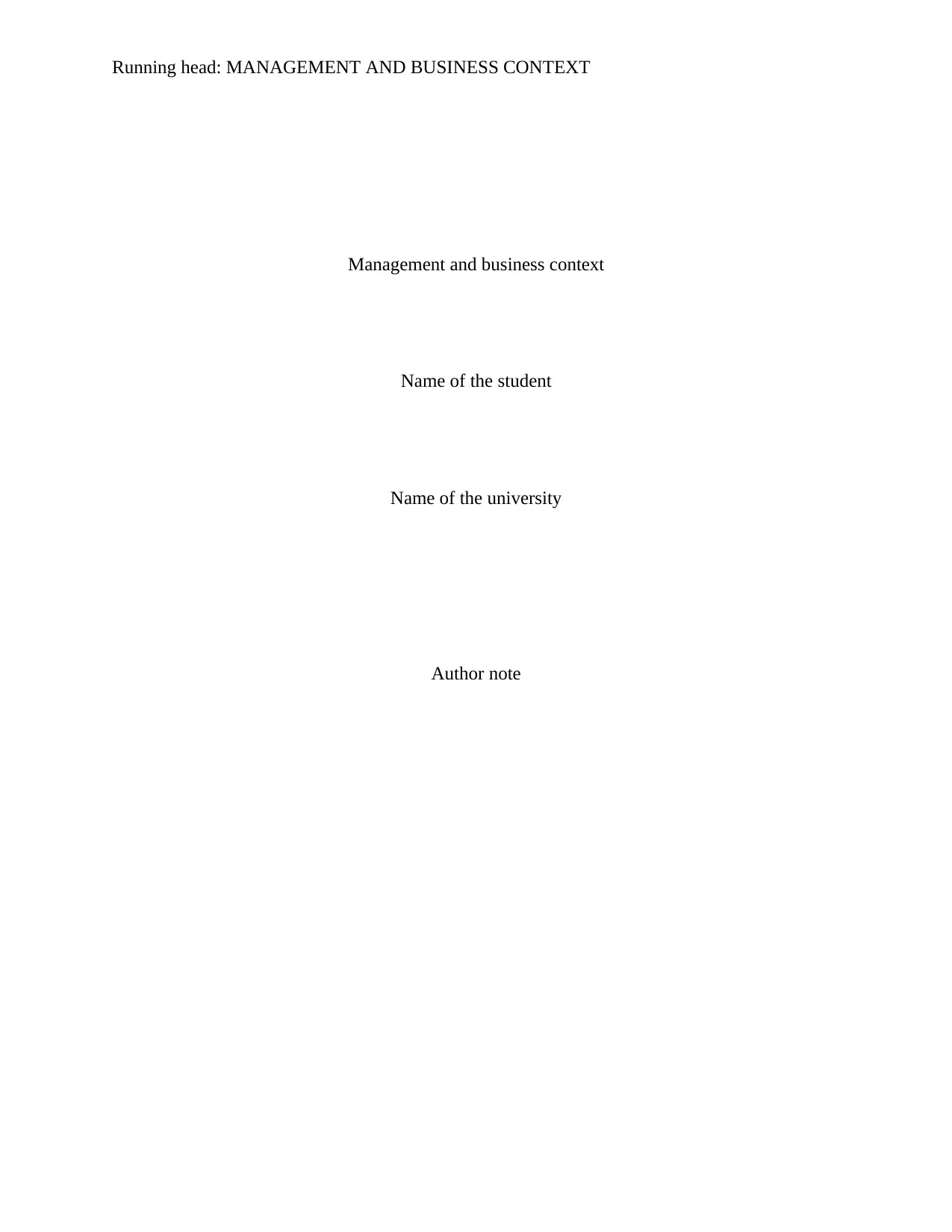
Running head: MANAGEMENT AND BUSINESS CONTEXT
Management and business context
Name of the student
Name of the university
Author note
Management and business context
Name of the student
Name of the university
Author note
Paraphrase This Document
Need a fresh take? Get an instant paraphrase of this document with our AI Paraphraser
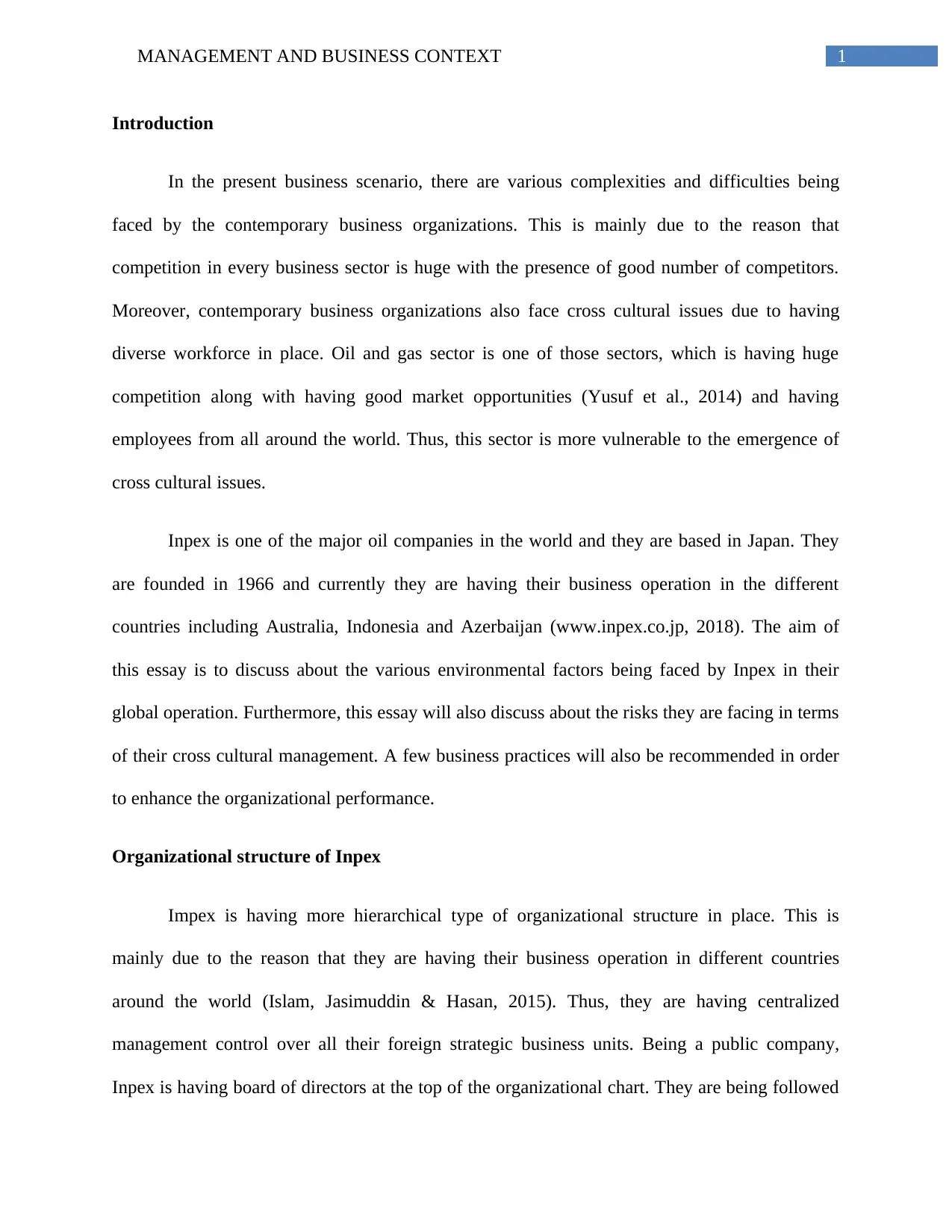
1MANAGEMENT AND BUSINESS CONTEXT
Introduction
In the present business scenario, there are various complexities and difficulties being
faced by the contemporary business organizations. This is mainly due to the reason that
competition in every business sector is huge with the presence of good number of competitors.
Moreover, contemporary business organizations also face cross cultural issues due to having
diverse workforce in place. Oil and gas sector is one of those sectors, which is having huge
competition along with having good market opportunities (Yusuf et al., 2014) and having
employees from all around the world. Thus, this sector is more vulnerable to the emergence of
cross cultural issues.
Inpex is one of the major oil companies in the world and they are based in Japan. They
are founded in 1966 and currently they are having their business operation in the different
countries including Australia, Indonesia and Azerbaijan (www.inpex.co.jp, 2018). The aim of
this essay is to discuss about the various environmental factors being faced by Inpex in their
global operation. Furthermore, this essay will also discuss about the risks they are facing in terms
of their cross cultural management. A few business practices will also be recommended in order
to enhance the organizational performance.
Organizational structure of Inpex
Impex is having more hierarchical type of organizational structure in place. This is
mainly due to the reason that they are having their business operation in different countries
around the world (Islam, Jasimuddin & Hasan, 2015). Thus, they are having centralized
management control over all their foreign strategic business units. Being a public company,
Inpex is having board of directors at the top of the organizational chart. They are being followed
Introduction
In the present business scenario, there are various complexities and difficulties being
faced by the contemporary business organizations. This is mainly due to the reason that
competition in every business sector is huge with the presence of good number of competitors.
Moreover, contemporary business organizations also face cross cultural issues due to having
diverse workforce in place. Oil and gas sector is one of those sectors, which is having huge
competition along with having good market opportunities (Yusuf et al., 2014) and having
employees from all around the world. Thus, this sector is more vulnerable to the emergence of
cross cultural issues.
Inpex is one of the major oil companies in the world and they are based in Japan. They
are founded in 1966 and currently they are having their business operation in the different
countries including Australia, Indonesia and Azerbaijan (www.inpex.co.jp, 2018). The aim of
this essay is to discuss about the various environmental factors being faced by Inpex in their
global operation. Furthermore, this essay will also discuss about the risks they are facing in terms
of their cross cultural management. A few business practices will also be recommended in order
to enhance the organizational performance.
Organizational structure of Inpex
Impex is having more hierarchical type of organizational structure in place. This is
mainly due to the reason that they are having their business operation in different countries
around the world (Islam, Jasimuddin & Hasan, 2015). Thus, they are having centralized
management control over all their foreign strategic business units. Being a public company,
Inpex is having board of directors at the top of the organizational chart. They are being followed
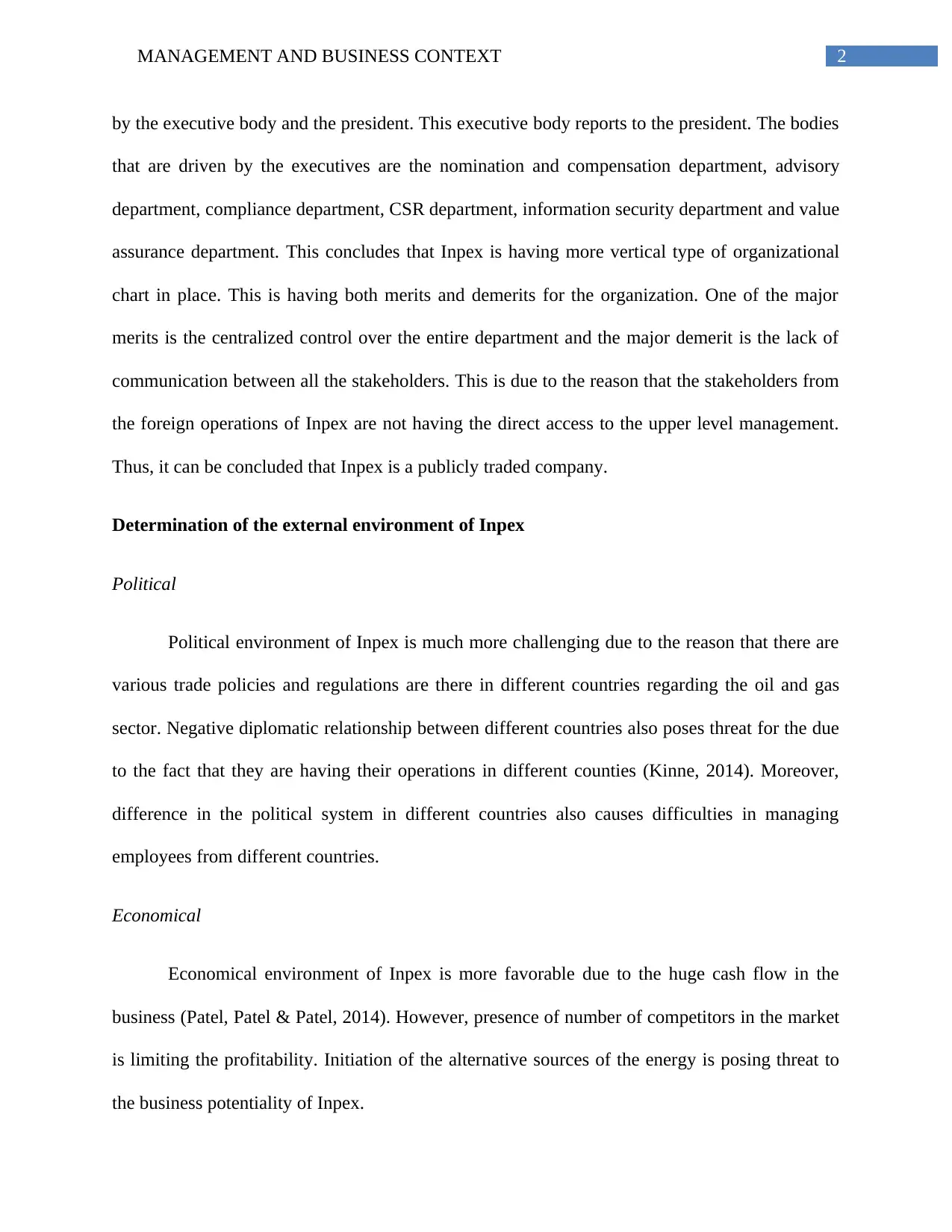
2MANAGEMENT AND BUSINESS CONTEXT
by the executive body and the president. This executive body reports to the president. The bodies
that are driven by the executives are the nomination and compensation department, advisory
department, compliance department, CSR department, information security department and value
assurance department. This concludes that Inpex is having more vertical type of organizational
chart in place. This is having both merits and demerits for the organization. One of the major
merits is the centralized control over the entire department and the major demerit is the lack of
communication between all the stakeholders. This is due to the reason that the stakeholders from
the foreign operations of Inpex are not having the direct access to the upper level management.
Thus, it can be concluded that Inpex is a publicly traded company.
Determination of the external environment of Inpex
Political
Political environment of Inpex is much more challenging due to the reason that there are
various trade policies and regulations are there in different countries regarding the oil and gas
sector. Negative diplomatic relationship between different countries also poses threat for the due
to the fact that they are having their operations in different counties (Kinne, 2014). Moreover,
difference in the political system in different countries also causes difficulties in managing
employees from different countries.
Economical
Economical environment of Inpex is more favorable due to the huge cash flow in the
business (Patel, Patel & Patel, 2014). However, presence of number of competitors in the market
is limiting the profitability. Initiation of the alternative sources of the energy is posing threat to
the business potentiality of Inpex.
by the executive body and the president. This executive body reports to the president. The bodies
that are driven by the executives are the nomination and compensation department, advisory
department, compliance department, CSR department, information security department and value
assurance department. This concludes that Inpex is having more vertical type of organizational
chart in place. This is having both merits and demerits for the organization. One of the major
merits is the centralized control over the entire department and the major demerit is the lack of
communication between all the stakeholders. This is due to the reason that the stakeholders from
the foreign operations of Inpex are not having the direct access to the upper level management.
Thus, it can be concluded that Inpex is a publicly traded company.
Determination of the external environment of Inpex
Political
Political environment of Inpex is much more challenging due to the reason that there are
various trade policies and regulations are there in different countries regarding the oil and gas
sector. Negative diplomatic relationship between different countries also poses threat for the due
to the fact that they are having their operations in different counties (Kinne, 2014). Moreover,
difference in the political system in different countries also causes difficulties in managing
employees from different countries.
Economical
Economical environment of Inpex is more favorable due to the huge cash flow in the
business (Patel, Patel & Patel, 2014). However, presence of number of competitors in the market
is limiting the profitability. Initiation of the alternative sources of the energy is posing threat to
the business potentiality of Inpex.
⊘ This is a preview!⊘
Do you want full access?
Subscribe today to unlock all pages.

Trusted by 1+ million students worldwide
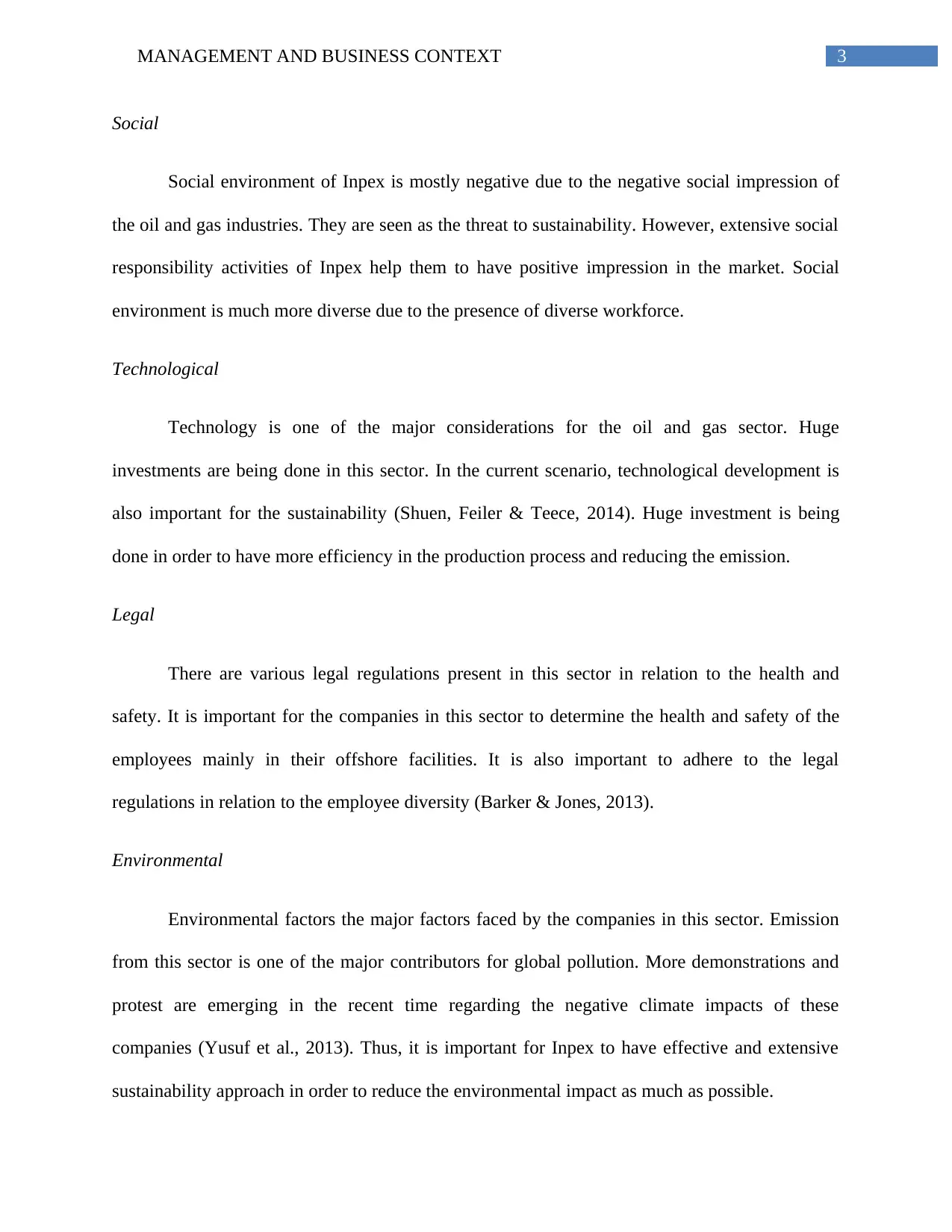
3MANAGEMENT AND BUSINESS CONTEXT
Social
Social environment of Inpex is mostly negative due to the negative social impression of
the oil and gas industries. They are seen as the threat to sustainability. However, extensive social
responsibility activities of Inpex help them to have positive impression in the market. Social
environment is much more diverse due to the presence of diverse workforce.
Technological
Technology is one of the major considerations for the oil and gas sector. Huge
investments are being done in this sector. In the current scenario, technological development is
also important for the sustainability (Shuen, Feiler & Teece, 2014). Huge investment is being
done in order to have more efficiency in the production process and reducing the emission.
Legal
There are various legal regulations present in this sector in relation to the health and
safety. It is important for the companies in this sector to determine the health and safety of the
employees mainly in their offshore facilities. It is also important to adhere to the legal
regulations in relation to the employee diversity (Barker & Jones, 2013).
Environmental
Environmental factors the major factors faced by the companies in this sector. Emission
from this sector is one of the major contributors for global pollution. More demonstrations and
protest are emerging in the recent time regarding the negative climate impacts of these
companies (Yusuf et al., 2013). Thus, it is important for Inpex to have effective and extensive
sustainability approach in order to reduce the environmental impact as much as possible.
Social
Social environment of Inpex is mostly negative due to the negative social impression of
the oil and gas industries. They are seen as the threat to sustainability. However, extensive social
responsibility activities of Inpex help them to have positive impression in the market. Social
environment is much more diverse due to the presence of diverse workforce.
Technological
Technology is one of the major considerations for the oil and gas sector. Huge
investments are being done in this sector. In the current scenario, technological development is
also important for the sustainability (Shuen, Feiler & Teece, 2014). Huge investment is being
done in order to have more efficiency in the production process and reducing the emission.
Legal
There are various legal regulations present in this sector in relation to the health and
safety. It is important for the companies in this sector to determine the health and safety of the
employees mainly in their offshore facilities. It is also important to adhere to the legal
regulations in relation to the employee diversity (Barker & Jones, 2013).
Environmental
Environmental factors the major factors faced by the companies in this sector. Emission
from this sector is one of the major contributors for global pollution. More demonstrations and
protest are emerging in the recent time regarding the negative climate impacts of these
companies (Yusuf et al., 2013). Thus, it is important for Inpex to have effective and extensive
sustainability approach in order to reduce the environmental impact as much as possible.
Paraphrase This Document
Need a fresh take? Get an instant paraphrase of this document with our AI Paraphraser
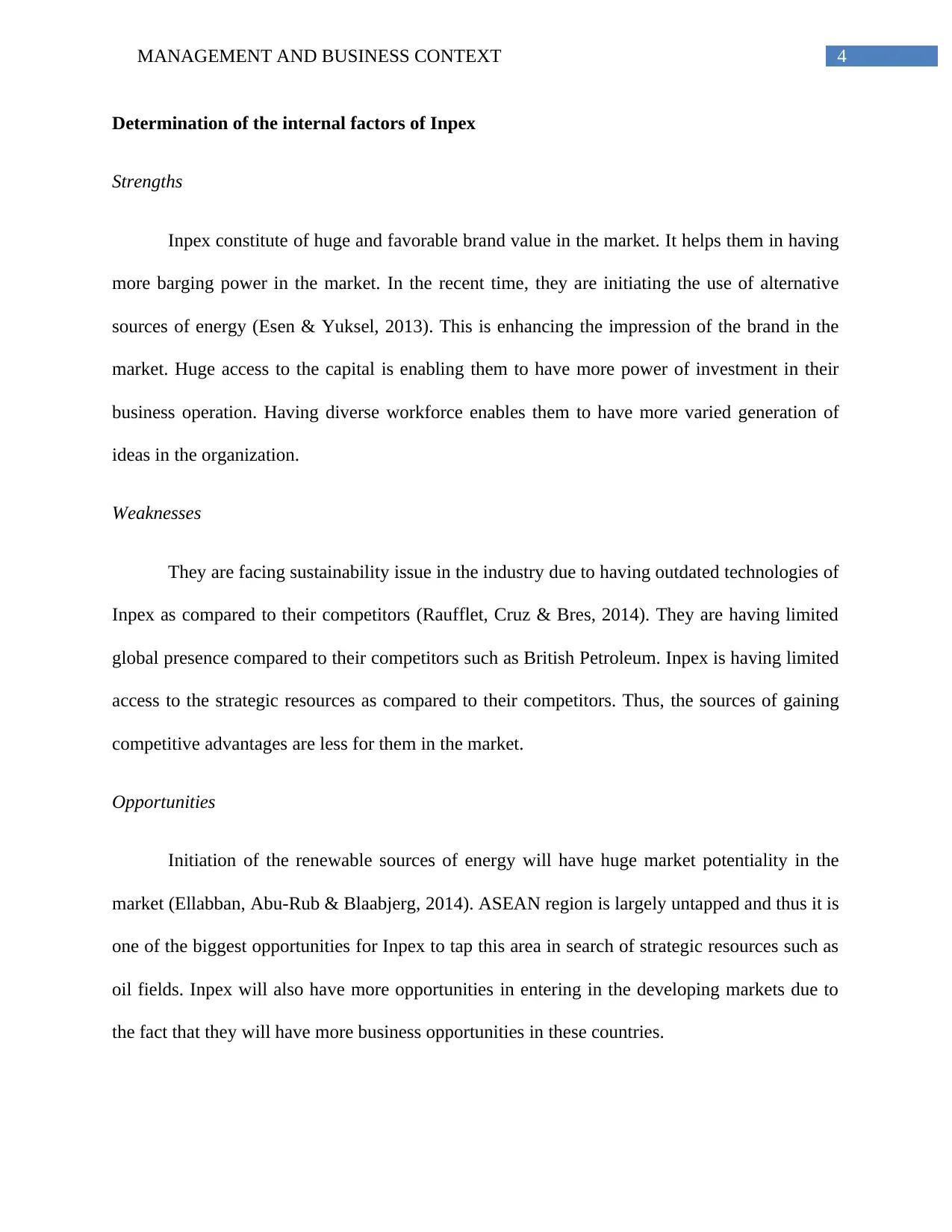
4MANAGEMENT AND BUSINESS CONTEXT
Determination of the internal factors of Inpex
Strengths
Inpex constitute of huge and favorable brand value in the market. It helps them in having
more barging power in the market. In the recent time, they are initiating the use of alternative
sources of energy (Esen & Yuksel, 2013). This is enhancing the impression of the brand in the
market. Huge access to the capital is enabling them to have more power of investment in their
business operation. Having diverse workforce enables them to have more varied generation of
ideas in the organization.
Weaknesses
They are facing sustainability issue in the industry due to having outdated technologies of
Inpex as compared to their competitors (Raufflet, Cruz & Bres, 2014). They are having limited
global presence compared to their competitors such as British Petroleum. Inpex is having limited
access to the strategic resources as compared to their competitors. Thus, the sources of gaining
competitive advantages are less for them in the market.
Opportunities
Initiation of the renewable sources of energy will have huge market potentiality in the
market (Ellabban, Abu-Rub & Blaabjerg, 2014). ASEAN region is largely untapped and thus it is
one of the biggest opportunities for Inpex to tap this area in search of strategic resources such as
oil fields. Inpex will also have more opportunities in entering in the developing markets due to
the fact that they will have more business opportunities in these countries.
Determination of the internal factors of Inpex
Strengths
Inpex constitute of huge and favorable brand value in the market. It helps them in having
more barging power in the market. In the recent time, they are initiating the use of alternative
sources of energy (Esen & Yuksel, 2013). This is enhancing the impression of the brand in the
market. Huge access to the capital is enabling them to have more power of investment in their
business operation. Having diverse workforce enables them to have more varied generation of
ideas in the organization.
Weaknesses
They are facing sustainability issue in the industry due to having outdated technologies of
Inpex as compared to their competitors (Raufflet, Cruz & Bres, 2014). They are having limited
global presence compared to their competitors such as British Petroleum. Inpex is having limited
access to the strategic resources as compared to their competitors. Thus, the sources of gaining
competitive advantages are less for them in the market.
Opportunities
Initiation of the renewable sources of energy will have huge market potentiality in the
market (Ellabban, Abu-Rub & Blaabjerg, 2014). ASEAN region is largely untapped and thus it is
one of the biggest opportunities for Inpex to tap this area in search of strategic resources such as
oil fields. Inpex will also have more opportunities in entering in the developing markets due to
the fact that they will have more business opportunities in these countries.
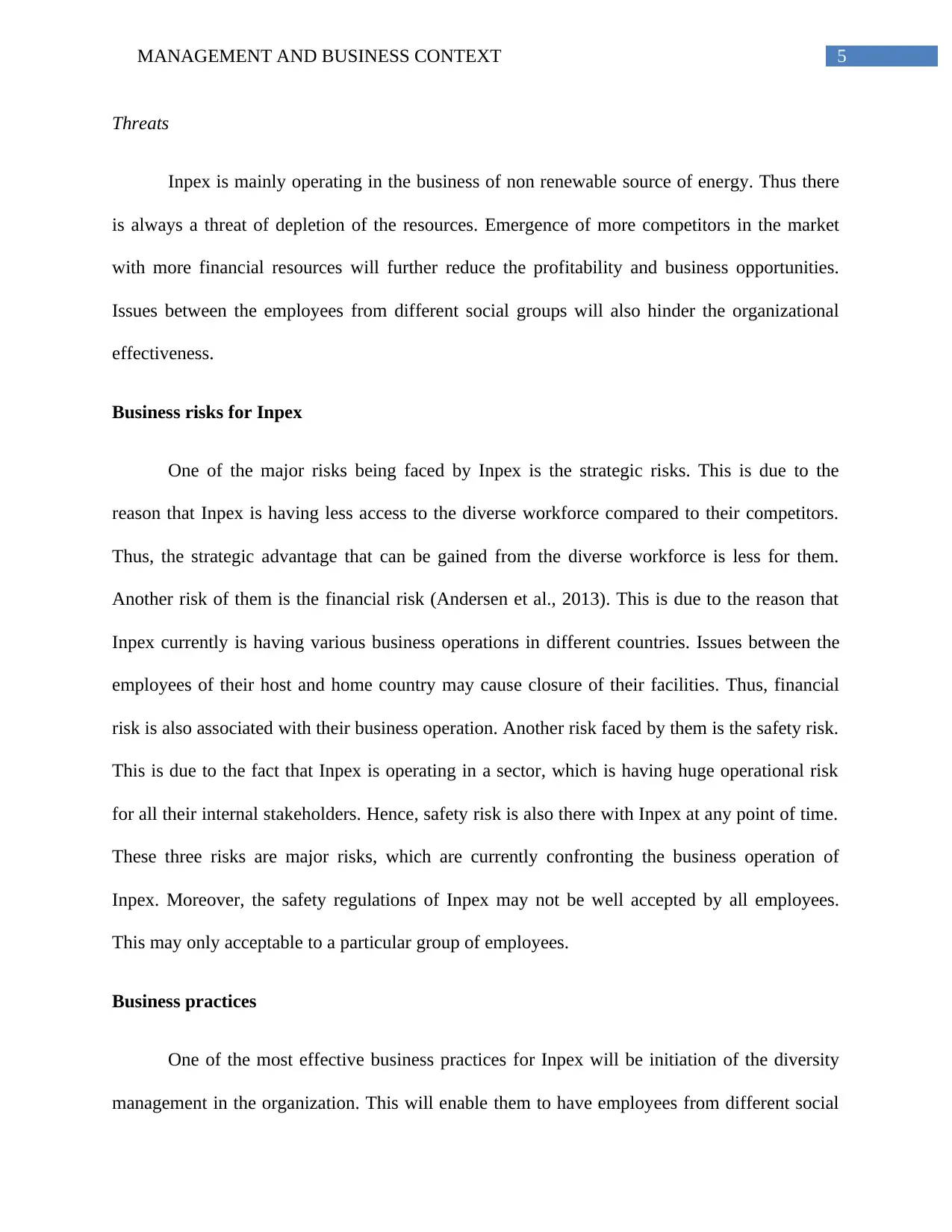
5MANAGEMENT AND BUSINESS CONTEXT
Threats
Inpex is mainly operating in the business of non renewable source of energy. Thus there
is always a threat of depletion of the resources. Emergence of more competitors in the market
with more financial resources will further reduce the profitability and business opportunities.
Issues between the employees from different social groups will also hinder the organizational
effectiveness.
Business risks for Inpex
One of the major risks being faced by Inpex is the strategic risks. This is due to the
reason that Inpex is having less access to the diverse workforce compared to their competitors.
Thus, the strategic advantage that can be gained from the diverse workforce is less for them.
Another risk of them is the financial risk (Andersen et al., 2013). This is due to the reason that
Inpex currently is having various business operations in different countries. Issues between the
employees of their host and home country may cause closure of their facilities. Thus, financial
risk is also associated with their business operation. Another risk faced by them is the safety risk.
This is due to the fact that Inpex is operating in a sector, which is having huge operational risk
for all their internal stakeholders. Hence, safety risk is also there with Inpex at any point of time.
These three risks are major risks, which are currently confronting the business operation of
Inpex. Moreover, the safety regulations of Inpex may not be well accepted by all employees.
This may only acceptable to a particular group of employees.
Business practices
One of the most effective business practices for Inpex will be initiation of the diversity
management in the organization. This will enable them to have employees from different social
Threats
Inpex is mainly operating in the business of non renewable source of energy. Thus there
is always a threat of depletion of the resources. Emergence of more competitors in the market
with more financial resources will further reduce the profitability and business opportunities.
Issues between the employees from different social groups will also hinder the organizational
effectiveness.
Business risks for Inpex
One of the major risks being faced by Inpex is the strategic risks. This is due to the
reason that Inpex is having less access to the diverse workforce compared to their competitors.
Thus, the strategic advantage that can be gained from the diverse workforce is less for them.
Another risk of them is the financial risk (Andersen et al., 2013). This is due to the reason that
Inpex currently is having various business operations in different countries. Issues between the
employees of their host and home country may cause closure of their facilities. Thus, financial
risk is also associated with their business operation. Another risk faced by them is the safety risk.
This is due to the fact that Inpex is operating in a sector, which is having huge operational risk
for all their internal stakeholders. Hence, safety risk is also there with Inpex at any point of time.
These three risks are major risks, which are currently confronting the business operation of
Inpex. Moreover, the safety regulations of Inpex may not be well accepted by all employees.
This may only acceptable to a particular group of employees.
Business practices
One of the most effective business practices for Inpex will be initiation of the diversity
management in the organization. This will enable them to have employees from different social
⊘ This is a preview!⊘
Do you want full access?
Subscribe today to unlock all pages.

Trusted by 1+ million students worldwide
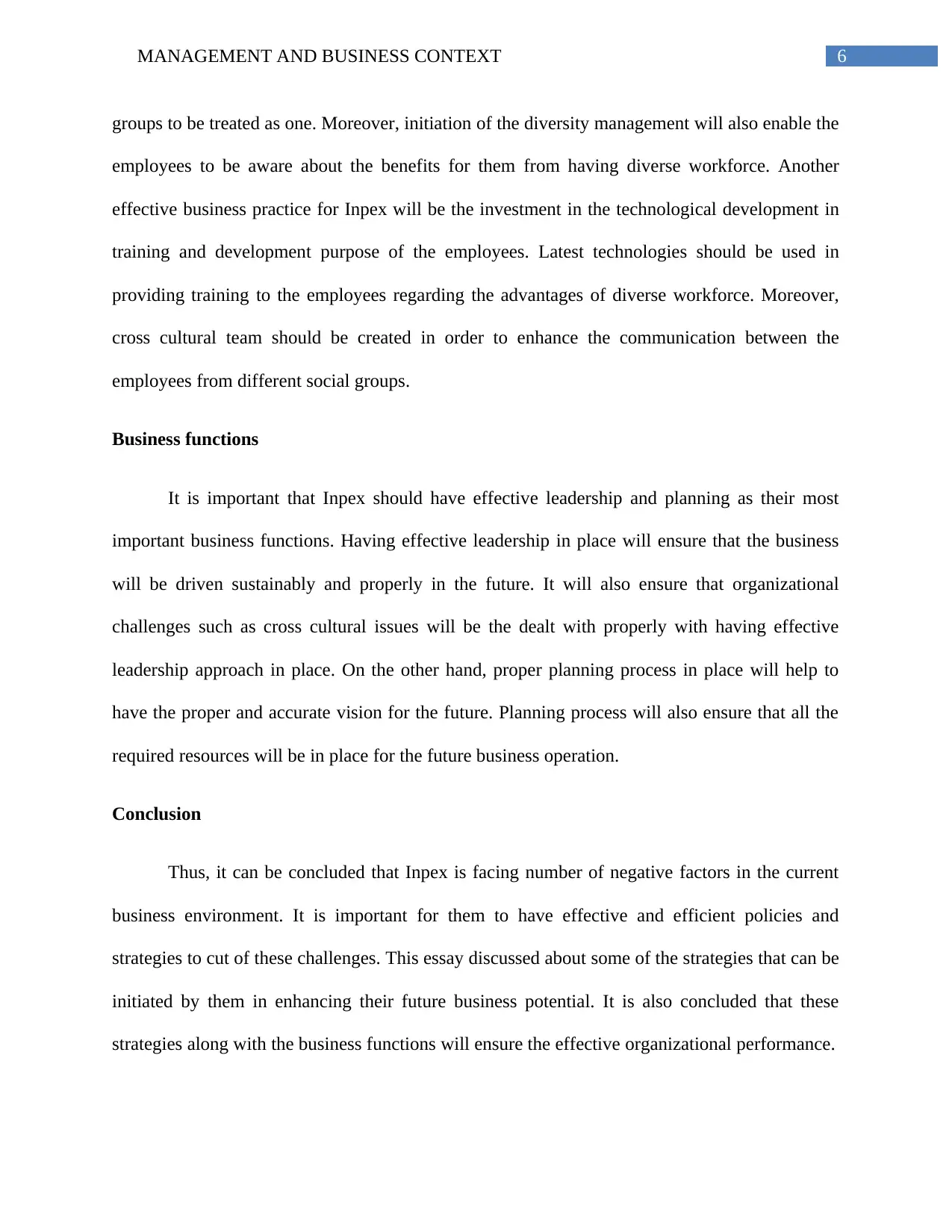
6MANAGEMENT AND BUSINESS CONTEXT
groups to be treated as one. Moreover, initiation of the diversity management will also enable the
employees to be aware about the benefits for them from having diverse workforce. Another
effective business practice for Inpex will be the investment in the technological development in
training and development purpose of the employees. Latest technologies should be used in
providing training to the employees regarding the advantages of diverse workforce. Moreover,
cross cultural team should be created in order to enhance the communication between the
employees from different social groups.
Business functions
It is important that Inpex should have effective leadership and planning as their most
important business functions. Having effective leadership in place will ensure that the business
will be driven sustainably and properly in the future. It will also ensure that organizational
challenges such as cross cultural issues will be the dealt with properly with having effective
leadership approach in place. On the other hand, proper planning process in place will help to
have the proper and accurate vision for the future. Planning process will also ensure that all the
required resources will be in place for the future business operation.
Conclusion
Thus, it can be concluded that Inpex is facing number of negative factors in the current
business environment. It is important for them to have effective and efficient policies and
strategies to cut of these challenges. This essay discussed about some of the strategies that can be
initiated by them in enhancing their future business potential. It is also concluded that these
strategies along with the business functions will ensure the effective organizational performance.
groups to be treated as one. Moreover, initiation of the diversity management will also enable the
employees to be aware about the benefits for them from having diverse workforce. Another
effective business practice for Inpex will be the investment in the technological development in
training and development purpose of the employees. Latest technologies should be used in
providing training to the employees regarding the advantages of diverse workforce. Moreover,
cross cultural team should be created in order to enhance the communication between the
employees from different social groups.
Business functions
It is important that Inpex should have effective leadership and planning as their most
important business functions. Having effective leadership in place will ensure that the business
will be driven sustainably and properly in the future. It will also ensure that organizational
challenges such as cross cultural issues will be the dealt with properly with having effective
leadership approach in place. On the other hand, proper planning process in place will help to
have the proper and accurate vision for the future. Planning process will also ensure that all the
required resources will be in place for the future business operation.
Conclusion
Thus, it can be concluded that Inpex is facing number of negative factors in the current
business environment. It is important for them to have effective and efficient policies and
strategies to cut of these challenges. This essay discussed about some of the strategies that can be
initiated by them in enhancing their future business potential. It is also concluded that these
strategies along with the business functions will ensure the effective organizational performance.
Paraphrase This Document
Need a fresh take? Get an instant paraphrase of this document with our AI Paraphraser
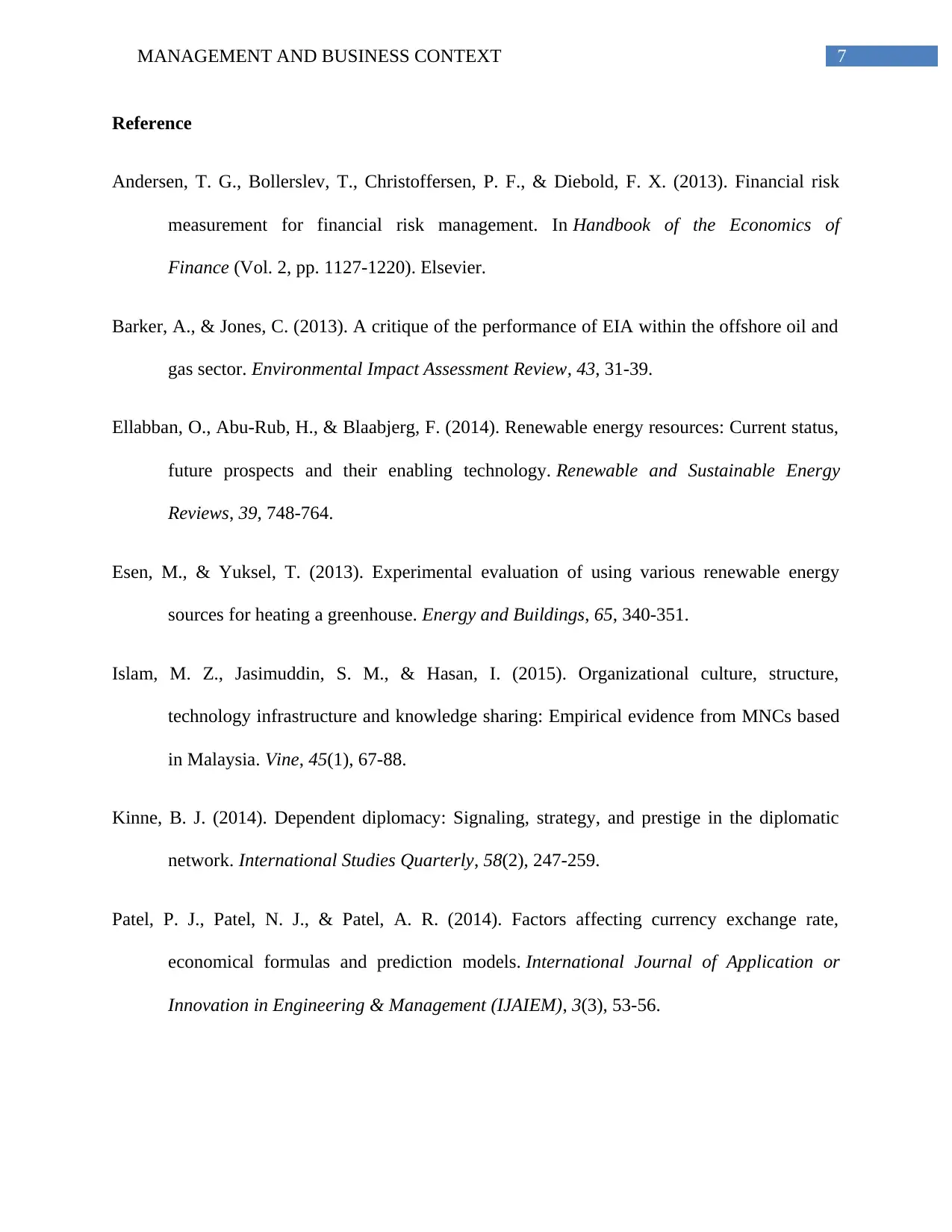
7MANAGEMENT AND BUSINESS CONTEXT
Reference
Andersen, T. G., Bollerslev, T., Christoffersen, P. F., & Diebold, F. X. (2013). Financial risk
measurement for financial risk management. In Handbook of the Economics of
Finance (Vol. 2, pp. 1127-1220). Elsevier.
Barker, A., & Jones, C. (2013). A critique of the performance of EIA within the offshore oil and
gas sector. Environmental Impact Assessment Review, 43, 31-39.
Ellabban, O., Abu-Rub, H., & Blaabjerg, F. (2014). Renewable energy resources: Current status,
future prospects and their enabling technology. Renewable and Sustainable Energy
Reviews, 39, 748-764.
Esen, M., & Yuksel, T. (2013). Experimental evaluation of using various renewable energy
sources for heating a greenhouse. Energy and Buildings, 65, 340-351.
Islam, M. Z., Jasimuddin, S. M., & Hasan, I. (2015). Organizational culture, structure,
technology infrastructure and knowledge sharing: Empirical evidence from MNCs based
in Malaysia. Vine, 45(1), 67-88.
Kinne, B. J. (2014). Dependent diplomacy: Signaling, strategy, and prestige in the diplomatic
network. International Studies Quarterly, 58(2), 247-259.
Patel, P. J., Patel, N. J., & Patel, A. R. (2014). Factors affecting currency exchange rate,
economical formulas and prediction models. International Journal of Application or
Innovation in Engineering & Management (IJAIEM), 3(3), 53-56.
Reference
Andersen, T. G., Bollerslev, T., Christoffersen, P. F., & Diebold, F. X. (2013). Financial risk
measurement for financial risk management. In Handbook of the Economics of
Finance (Vol. 2, pp. 1127-1220). Elsevier.
Barker, A., & Jones, C. (2013). A critique of the performance of EIA within the offshore oil and
gas sector. Environmental Impact Assessment Review, 43, 31-39.
Ellabban, O., Abu-Rub, H., & Blaabjerg, F. (2014). Renewable energy resources: Current status,
future prospects and their enabling technology. Renewable and Sustainable Energy
Reviews, 39, 748-764.
Esen, M., & Yuksel, T. (2013). Experimental evaluation of using various renewable energy
sources for heating a greenhouse. Energy and Buildings, 65, 340-351.
Islam, M. Z., Jasimuddin, S. M., & Hasan, I. (2015). Organizational culture, structure,
technology infrastructure and knowledge sharing: Empirical evidence from MNCs based
in Malaysia. Vine, 45(1), 67-88.
Kinne, B. J. (2014). Dependent diplomacy: Signaling, strategy, and prestige in the diplomatic
network. International Studies Quarterly, 58(2), 247-259.
Patel, P. J., Patel, N. J., & Patel, A. R. (2014). Factors affecting currency exchange rate,
economical formulas and prediction models. International Journal of Application or
Innovation in Engineering & Management (IJAIEM), 3(3), 53-56.
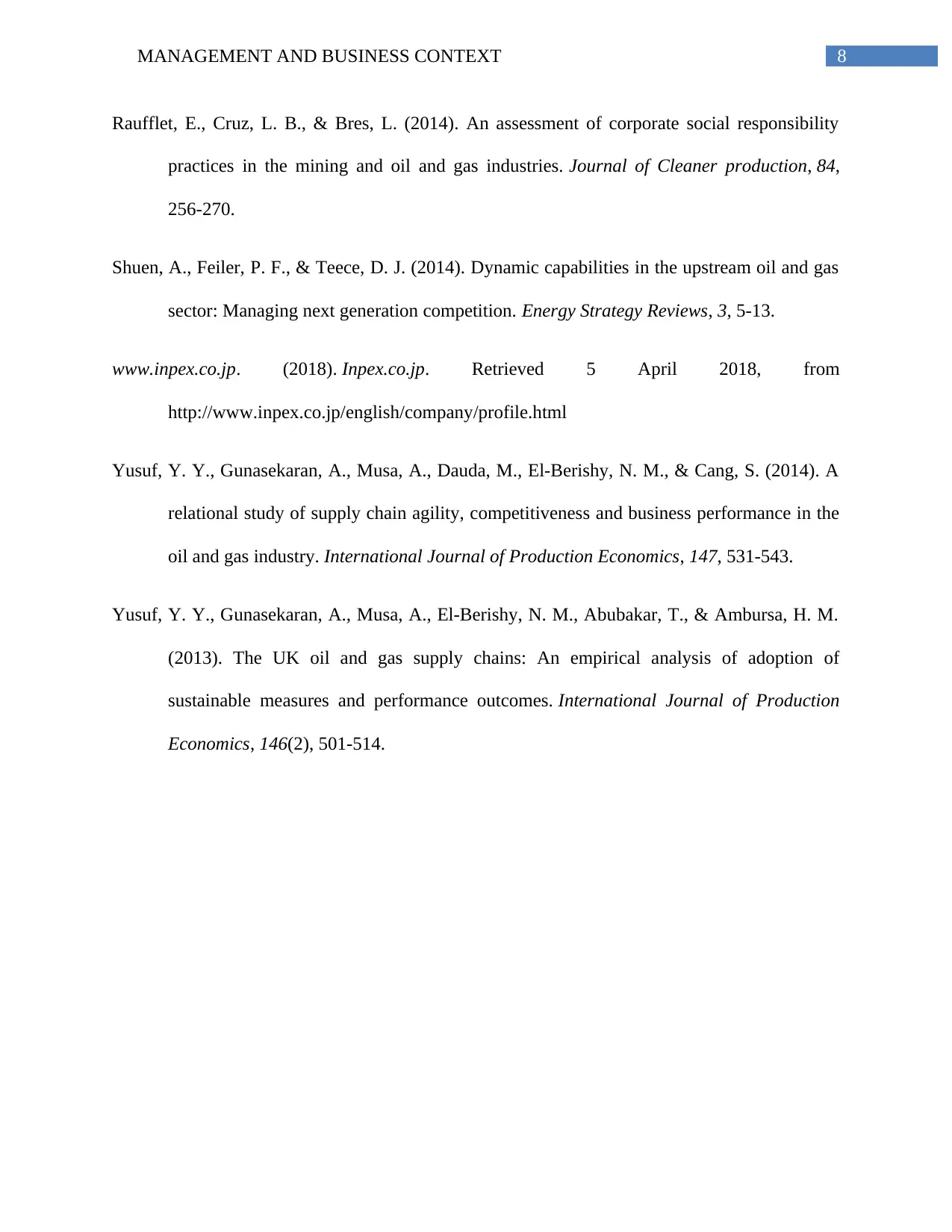
8MANAGEMENT AND BUSINESS CONTEXT
Raufflet, E., Cruz, L. B., & Bres, L. (2014). An assessment of corporate social responsibility
practices in the mining and oil and gas industries. Journal of Cleaner production, 84,
256-270.
Shuen, A., Feiler, P. F., & Teece, D. J. (2014). Dynamic capabilities in the upstream oil and gas
sector: Managing next generation competition. Energy Strategy Reviews, 3, 5-13.
www.inpex.co.jp. (2018). Inpex.co.jp. Retrieved 5 April 2018, from
http://www.inpex.co.jp/english/company/profile.html
Yusuf, Y. Y., Gunasekaran, A., Musa, A., Dauda, M., El-Berishy, N. M., & Cang, S. (2014). A
relational study of supply chain agility, competitiveness and business performance in the
oil and gas industry. International Journal of Production Economics, 147, 531-543.
Yusuf, Y. Y., Gunasekaran, A., Musa, A., El-Berishy, N. M., Abubakar, T., & Ambursa, H. M.
(2013). The UK oil and gas supply chains: An empirical analysis of adoption of
sustainable measures and performance outcomes. International Journal of Production
Economics, 146(2), 501-514.
Raufflet, E., Cruz, L. B., & Bres, L. (2014). An assessment of corporate social responsibility
practices in the mining and oil and gas industries. Journal of Cleaner production, 84,
256-270.
Shuen, A., Feiler, P. F., & Teece, D. J. (2014). Dynamic capabilities in the upstream oil and gas
sector: Managing next generation competition. Energy Strategy Reviews, 3, 5-13.
www.inpex.co.jp. (2018). Inpex.co.jp. Retrieved 5 April 2018, from
http://www.inpex.co.jp/english/company/profile.html
Yusuf, Y. Y., Gunasekaran, A., Musa, A., Dauda, M., El-Berishy, N. M., & Cang, S. (2014). A
relational study of supply chain agility, competitiveness and business performance in the
oil and gas industry. International Journal of Production Economics, 147, 531-543.
Yusuf, Y. Y., Gunasekaran, A., Musa, A., El-Berishy, N. M., Abubakar, T., & Ambursa, H. M.
(2013). The UK oil and gas supply chains: An empirical analysis of adoption of
sustainable measures and performance outcomes. International Journal of Production
Economics, 146(2), 501-514.
⊘ This is a preview!⊘
Do you want full access?
Subscribe today to unlock all pages.

Trusted by 1+ million students worldwide
1 out of 9
Related Documents
Your All-in-One AI-Powered Toolkit for Academic Success.
+13062052269
info@desklib.com
Available 24*7 on WhatsApp / Email
![[object Object]](/_next/static/media/star-bottom.7253800d.svg)
Unlock your academic potential
Copyright © 2020–2025 A2Z Services. All Rights Reserved. Developed and managed by ZUCOL.




